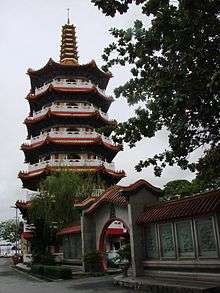Tua Pek Kong Temple, Sibu
| Tua Pek Kong Temple 永安厅大伯公庙 | |
|---|---|
 The Tua Pek Kong Temple | |
| Basic information | |
| Location | Sibu |
| Geographic coordinates | 2°17′14″N 111°49′34″E / 2.28722°N 111.82611°ECoordinates: 2°17′14″N 111°49′34″E / 2.28722°N 111.82611°E |
| Affiliation | Taoism |
| District | Sibu District |
| State | Sarawak |
| Country | Malaysia |
| Architectural description | |
| Architectural type | Pagoda |
| Date established | unknown |
| Completed | 1870 |
Tua Pek Kong Temple in Sibu, Sarawak, Malaysia is an icon of the town with its 7-storey pagoda. Its history dates back to 1870. The temple is also known as Sibu Eng Ann Teng Tua Pek Kong Temple (永安厅大伯公庙).
The history of the temple dates back to early 1870. In the 1871 Sarawak Gazette, it was recorded that there was a small wooden Chinese temple in Sibu and that was the Tua Peh Kong Temple.[1]
In 1897, the temple was rebuilt into a typical Chinese temple designed with tiled roof, stone block floor and all the decorative purlin and fixtures which were imported from China. The statue of Tua Pek Kong deity was specially sculptured and imported from Xiamen, China. After the building was completed, the list of donors and details of expenditure were recorded in two pieces of stone tablet which are still well preserved in the temple.
On 8 March 1928 Sibu town was destroyed by a big fire, but the temple was unscathed.[2] This was regarded as a miracle by the locals.
In 1942, the Japanese invaded and occupied Sibu. In 1945, the Allied Forces bombarded Sibu. The town and the temple were severely destroyed but the state of the deity was unharmed. After the Second World War, the wooden structure temple was rebuilt.
In 1957, the temple was reconstructed into a concrete structure and was declared open by the then Governor of Sarawak, Sir Anthony Abell. It was a grand occasion for the Sibu Town as the British Royal dignitaries including the Resident attended the ceremony.
In 1979, renovation of both wings of the temple was again being carried out and the roof of temple was changed from belian wood into concrete with glazed roofing tiles; the ridge or roof and column were decorated with traditional dragon and phoenix statues. The renovated building was declared open in 1980.
In 1987, under the generous patronage of the Sarawak State Government and the worshippers, the rear section of the temple was demolished and replaced by a 7-storey Pagoda for the worship of the Goddess of Mercy. This Pagoda building followed closely traditional Chinese Pagoda Architecture. Thus, the temple became a landmark of Sibu. The total expenditure of the building was RM1.5 million and was declared open on 4 May 1989.
The temple and its recognisable pagoda is a symbol of the sovereign and kindness of the deity for the worshipper and a prime tourist attraction for the town.
Tua Pek Kong Temple in Sibu, Sarawak, Malaysia is an icon of the town with its 7storey pagoda. Its history datesback to 1870. The temple is also known as Sibu Eng Ann Teng Tua Pek Kong Temple. The history of the temple dates back to early 1870. In the 1871 Sarawak Gazette, it was recorded that there was a small wooden Chinese temple in Sibu and that was the Tua Pek Kong Temple.
In 1897, the temple was rebuilt into a typical Chinese temple designed with tiled roof, stone block floor and all the decorative purlin and fixtures which were imported from China. The statue of Tua Pek Kong deity was specially sculptured and imported from Xiamen, China. After the building was completed, the list of donors and details of expenditure were recorded in two pieces of stone tablet which are still well preserved in the temple. On 8 March 1928 Sibu town was destroyed by a big fire, but the temple was unscathed.This was regarded as a miracleby the locals.
In 1942, the Japanese invaded and occupied Sibu. In 1945, the Allied Forces bombarded Sibu. The town and the temple were severely destroyed but the state of the deity was unharmed. After the Second World War, the wooden structure temple was rebuilt. In 1957, the temple was reconstructed into a concrete structure and was declared open by the then Governor of Sarawak, Sir Anthony Abell. It was a grand occasion for the Sibu Town as the British Royal dignitaries including the Resident attended the ceremony.
In 1979, renovation of both wings of the temple was again being carried out and the roof of temple was changed from belian wood into concrete with glazed roofing tiles; the ridge or roof and column were decorated with traditional dragon and phoenix statues. The renovated building was declared open in 1980.
In 1987, under the generous patronage of the Sarawak State Government and the worshippers, the rear section of the temple was demolished and replaced by a 7storey Pagoda for the worship of the Goddess of Mercy. This Pagoda building followed closely traditional Chinese Pagoda Architecture. Thus, the temple became a landmark of Sibu. The total expenditure of the building was RM1.5 million and was declared open on 4 May 1989. The temple and its recognisable pagoda is a symbol of the sovereign and kindness of the deity for the worshipper and a prime tourist attraction for the town.
See also
References
| Wikimedia Commons has media related to Tua Pek Kong Temple, Sibu. |
- ↑ "TUA PEK KONG TEMPLE & GODDESS OF MERCY PAGODA". Sarawak Tourism. Sarawak Tourism. 17 July 2013. Retrieved 18 February 2013.
- ↑ "TUA PEK KONG TEMPLE & GODDESS OF MERCY PAGODA". Visit Sibu. Visit Sibu]. 17 July 2013. Retrieved 18 February 2013.